|
 a
journey to remember . . . a
journey to remember . . .
Marianna Army
Air Field
Advanced Single
Engine School
Marianna, Florida
|
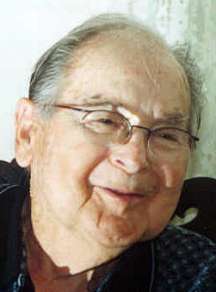
William
Tillery, 2001
|
By William W. Tillery
| The Southeast
Army Air Force Training Command, (one of three Army Air Force Training
Centers) Headquarters Maxwell Field, Montgomery, Alabama. Southeast
AAF Training Command, with bases as far west as North Dakota, extended
to South Florida. Most of the Army Airfields were located in Alabama,
Georgia and Florida. Tens of thousands of WWII pilots, bombardiers
and navigators were trained at these airfields. They came from all
walks of life. Starting in 1941, several thousand British cadets
trained for the RAF. In the beginning, young men accepted for pilot
training were sent |
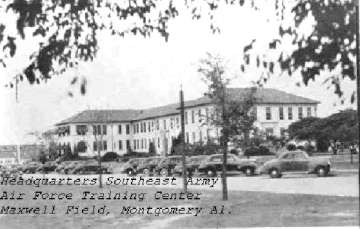
Headquarters Southeast Army
Air Force Training Center
Maxwell Field, Montgomery Alabama, 1945 |
to a cadet classification center for induction.
This is the first arduous but rewarding step on the road to their Army
Air Force wings. In the next step, the candidate is transformed from a
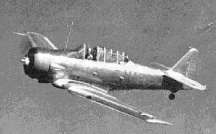
AT-6 in flight
|
civilian into an AAF cadet. Within
the next few days the cadet will be classified by aptitude tests
for pilot, bombardier or navigator training. Upon completing
training at one of the specialized schools he will receive his
wings and become a flight officer. Then he is ready to join the United States air
armada in combat.
After completing the tests in the
Classification Centerthe men are assigned to pre-flight. Pre-flight
training programs
|
were classified into three
major fields — athletics, military, and academic. Upon completion
of the grueling nine weeks of pre-flight training, cadets were
sent to a primary flight school. Here they
| continued
the same training as in pre-flight but more intense. In primary,
they were introduced to flying. Most of the flight instructors
were civilian pilots. In primary flight school the cadets learned
if they had the inherent ability to fly. After twelve hours grueling
of dual flight with a flight instructor, came the day to solo.
Cadets had made countless take-offs, landings, and many different |
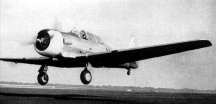
AT-6 taking off |
maneuvers with his instructor
observing each one. The day the cadet was scheduled to solo,
he was tense but eager to take-off. He was eager to prove he
was worthy of the training he had
|
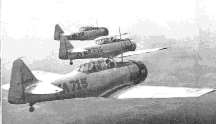
3 AT-6s Flight
Echelon
|
received in pursuit of his wings.
The student cadet had done everything his instructor called upon
him to do. Most of the cadets, after soloing, went to basic flight
training, however some washed out. Those cadets who washed out
could go on to bombardier or navigator school.
Basic flight starts by the cadet being
introduced to a more powerful
aircraft and a more demanding flying techniques. On the flight
line after sundown they e prepared for night flying. Basic instrument
flying, together with day and night cross-country
|
flying,is part of basic flight training. On
cross-country flights the cadet put to use the navigation skills he had
learned in the classroom. Phase by phase the cadets were being molded
into competent aviators.
| The next
and final phase of his flight training was Advanced Flying. Marianna
Army Air Field was a typical AAF Advanced Single Engine School.
Marianna, Florida was chosen in early 1942 as one of many Army
Air Forces training bases. In the beginning the Army acquired
the city of Marianna airport with its dirt runway and approximately
2000 adjacent acres of cotton, corn and peanut fields. Afterward,
these fields were transformed |
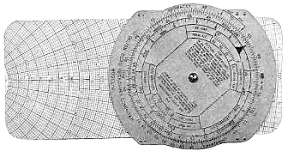
E-6b |
into Marianna AAF. With the
land secured, the Army Corps of Engineers drew up plans while
the contractors started construction. The main base, auxiliary
fields and runways were started in late April 1942. Within six
months the Marianna AAF had started its first pilot training
class.
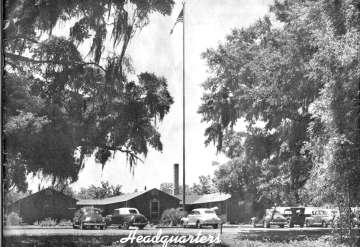
These Headquarters buildings were
among the first
to be completed, and occupied by newly arriving
Army Air Force support personnel. |
So
rapid was the construction that by August 1942 the landing fields
were near completion. At the same time, quarters and other buildings
were completed. Officers and enlisted men moved in as they finished.
They came by truck convoy and troop train from other Southeastern
Army Air Force Training Centers. Among these officers and enlisted
men were Training Instructors who started classes in all phases
of flight training: r Flight Instructors, Academic Instructors,
Link Instructors and Aircraft Maintenance. Not only did training
go on in the classroom, |
there was on-the-job training for personnel in
many areas. This was the beginning of Marianna AAF - ready to take
its place among the many other Army Air Force Training Bases. By year's
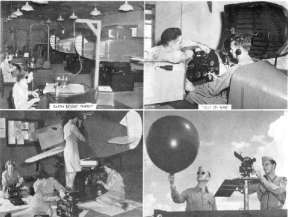
Link trainer
department
These
are scenes in one of the three Link Trainer buildings at Marianna
AAF during WWII. Each of the three buildings had eight trainers
at full mobilization. In 1943 and 1944 these twenty-four trainers
were operated sixteen hours a day. Top left: Link Instructors
conducting an exercise in simulated instrument flying. Top right:
A Link Instructor briefing a Cadet on instrument flying procedures.
Bottom left: WACs performing routine maintenance on a Link trainer.
Bottom right: Weather Men preparing to check the ceiling and
winds aloft.
|
end the sky around
Marianna AAF was full of training aircraft. This intense pilot training
continued until mid 1945 when the end of the war could be predicted.
The first few hours of advanced flying was devoted to transition
and formalization. During this time the cadets are introduced to
retractable landing gear, constant speed propellers, and hydraulic
flaps while flying a faster and heavier airplane. In the advanced
phase the cadets were introduced to Link Trainers which simulate
the airplane. In the Link Trainer the cadets were taught instrument
procedures which were later practiced in the aircraft under the
hood. The first night cross-country flight was always looked upon
as a challenging mission by the cadets. Flying took up only part
of a long and grueling day. The cadets finished out the day by participating
in classroom, drilling, and athletics. By taps, most of the cadets
were in the sack. All other officers and inlisted men were required
to take part in classroom, drilling, and athletic endeavors. Staying
active, they did a better job. This astounding |
accomplishment, completed within a few months,
was repeated hundreds of times throughout the United States. 1942 was
the year that the Army Air Force came of age. Within a year the tide of
war had shifted in favor of the allies. This was due to the predominant
allied air power over the axis and Japan. Along with pilots, bombardiers,
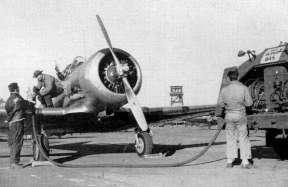
AT-6 being refueled
|
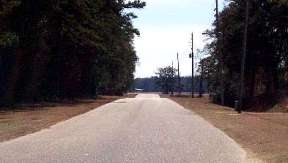
Flight Line Street 2001 |
and navigators, air crewmen, aircraft mechanics,
radio technicians and other ground support personnel were trained at these
bases. The support personnelincluded civilians and military men
and women working
around the clock to keep the aircraft flying. This dedication to
service and country kept the flow of trained military personnel
to the theaters of war around the world. These highly trained military
support personnel were locked into their respected positions. Very
few were rotated to advanced bases overseas, because it took too
long to train a replacement.
Those young men and women took their assignment with sober determination
— never looking back. They kept their eyes focused on the goal
— winning the war. Those young men and women did an outstanding
job of keeping the aircraft flying. As new air bases were completed
and activated, men were transferred from established bases. These
well qualified men would train recruits to do the job and task that
lay ahead. An aptitude test was given to determine the appropriate
assignment. Mostly, an attempt was made to put people in jobs comparable
to their civilian occupation. By taking advantage of their civilian
training the Army Air Force saved time and resources in crosstraining.
Looking back |
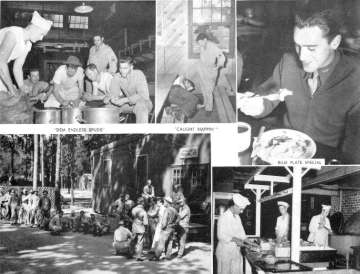
Consolidated
mess no. 2
These were familiar scenes around the two consolidated mess halls
at MAAF. Thousand of GIs were fed three meals a day and a midnight
meal for men going on or off duty at that time. Here many GIs
from outside of the South ate their first Georgia ice cream [Grits]
and came in contact with those pesky gnats. Top left: This was
a familiar scene in and around scullery peeling potatoes. The
Army seems to never run out of potatoes and the peeling went
on around the clock. Top center: A KP caught napping. Bottom
left: A scene like this chow line was a daily event prior to
meal time. The GIs in the line were known as "Chow Hounds".
Bottom right: Mess Sergeant, mess cooks and KPs are preparing
the next meal. |
| with pride on
my four plus years service in the Army Air Force, I can say for
certain that the men and women that I was associated with in the
Army Air Force Training Command were hard working service personnel.
They were committed to doing the very best job in training a complete
aviator. These young men and women were also devoted to the Air
Force and its commitment to send into battle the very best pilots
in the world. In my opinion that was what we did. At times the demands
were great, but these service men and women stayed the
course. They saw the victorious conclusion of World War II over
the most hideous enemiesin |
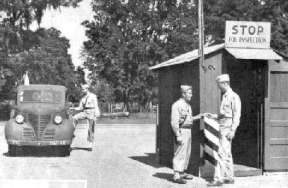
Main Gate 1945 Through this gate
passed eager young men and women to train for their duties as
the Army Air Force's finest aviators and ground support personnel. |
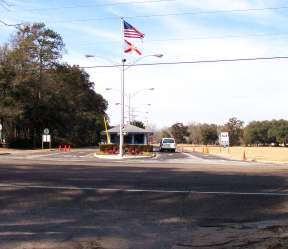
Main Gate 2001
|
all of recorded history. State-side
service men and women II have not received their just recognition
of a job well done during WWII. This is not intended to detract
from brave deeds in battle. I had many friends as well as a brother
who went into battle around the world on land, sea, and in the
air. They deserve all the accolades that have been bestowed on
these valiant men and women throughout the war years.
|
The Chapel
|
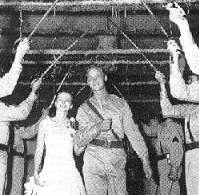
Bride and Groom |
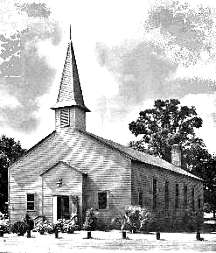
Chapel 1945
|
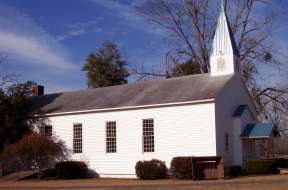
Chapel 2001 |
| The
Chapel was a familiar scene of religious activities on Sundays
as well as Thanksgiving, Christmas and other religious holidays.
These religious activities were attended by men and women of
all religious persuasions. The Chapel also was the setting for
many weddings of newly commissioned 2nd Lieutenants and their
sweethearts. |
Operations
|
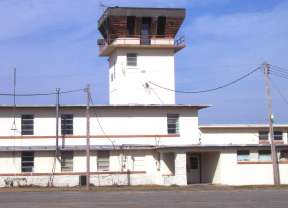
Control Tower 2001
Post Operation as viewed from the ramp.
The duties that were carried out by Post Operation were hosting
transient aviators and servicing their aircraft. Arraignments
were made for overnight stays and taxi service was provided for
aviators and crew members. Gathering and issuing weather reports
was part of the daily routine at Post Operations as well issuing
VFR and IFR clearances to pilots. The Tower was part of Post Operation.
It, too, issued VFR and
IFR flight
|
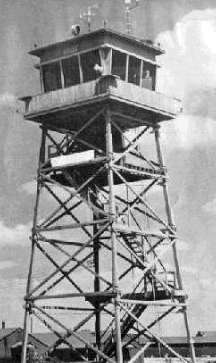
Control Tower 1945 |
| clearances
in close cooperation with Operations. The
Tower directed aircraft traffic on the ground and in the air as
well as giving take-off and landing instructions. These operation
duties, as well as many post duties, were carried out day and night
365 days a year. |
The Base Hospital
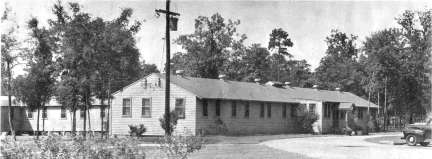
Hospital in 1945
|
|
The Hospital was well
equipped and staffed with highly trainer Doctors and Nurses.
GI's were trained as orderlies and kept the hospital as though
it was getting ready for an IG inspection. The hospital had very
good medical technicians for they were forever giving shots!
Medical and Dental doctors were ready for any emergency from
an acheing tooth to an emergency appendectomy. |
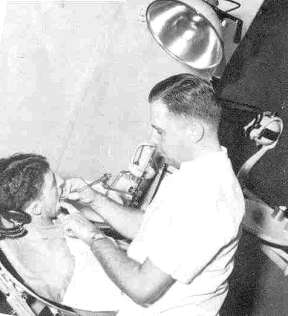
The yanks are coming!! Does it hurt? |
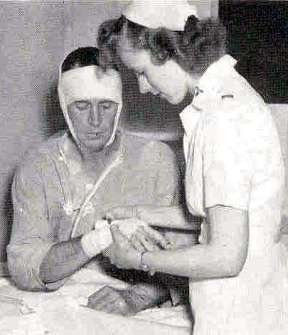
Wounded with Nurse |
The WACs are Here
|
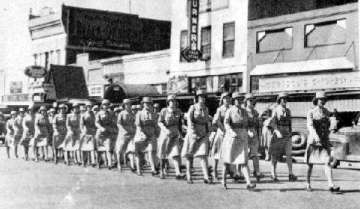
WACs on Parade |
In 1943 a detachment of WAC's arrived in Marianna
and were assigned to MAAF where they were well received by GI's.
Within a few days after arrival, a contingent of WACs were assigned
to the Link Trainer Department. At that time the Link Department
had started expanding its operation to twenty-four trainers and
needed more personnel to train as instructors. Without delay
we started training
the WAC's in the techniques of simulated instrument flying. They
applied themselves and learned fast. In a short time we had most
of |
| them
instructing student pilots. These girls were American's finest
daughters, sincere and dedicated to the war effort. They proved
themselves over again and again during their tour of duty with
the Link Department and I am proud to have known these young
ladies. |
The Ramp
|
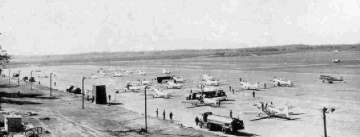
The Ramp 1945 |
The east side of the field and ramp as seen
from tower. After a flight, the plane parked on the ramp. The
crew chief and his maintenance crew swung into action. First
the crew chief checked the aircraft's log for maintenance discrepancies
written up by the pilot. Crew members trained to work on various
aircraft systems would then proceed to correct any malfunction that was noted in the
log or observed |
| observed during
the inspection. Early each flying day a member of the aircraft's
maintenance team was assigned to run up and shut down the aircraft's
engine. This pre-flight assured that the plane was ready for
flight. GI,s living in barracks near the flight line didn't need
an alarm clock to awaken them, that was taken care of with the
roaring sound of 75 to 100 AT6 engines early the morning. |
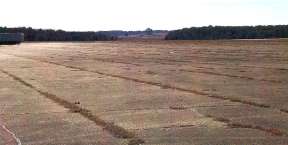
The Ramp 2001 |
Rest and Relaxation
|
|
The PX was the place where
off duty service personnel could relax while having a snack and
a beer or two. The PX carried a full line of necessities. A restaurant
in the same building was always busy around payday.
Picnicking, swimming and fishing
at nearby Blue Springs was a favorite place for off duty GIs
to relax. In 1945 when the war was coming to an end and GIs had
more leisure time, it was spent at Blue Springs and the Caverns
Golf Course.
|
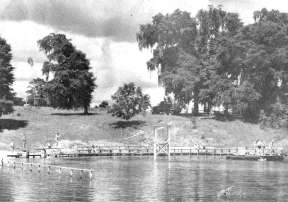
R&R at Blue Springs 1945 |
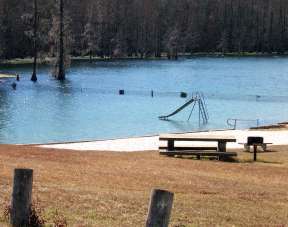
R&R at Blue Springs 2001 |
The theatre was a place to
relax in dreamland for a few hours where first-rate movies were
shown nightly. From time to time USO shows were scheduled at
the theatre with dancers, comedians, magicians, ventriloquists,
and vaudeville acts. These USO shows with their enthusiastic
and dedicated troupers were a morale builder for all who attended.
|
Thank you for your interest
in the "Marianna Revisited" page. I hope this will
renew some old memories of WWII for those who were stationed
there. For those not acquainted with the mission at Marianna
Army Air Field during WWII, I hope you will be enlightened.
Revisited in 2001
| Shortly after WWII, Marianna AAF
was re-opened as a United States Air Force Contract Primary Flying
School. In 1951 Graham Aviation School started training Air Force
primary students and continued to train students until 1961.
During this time the base was much like it was at its closing
after the war. After closing Graham Aviation the base began to
decline. Buildings were sold off and many were left to rot. One
must remember that the buildings were temporary and weren't intended
to last for many years. |
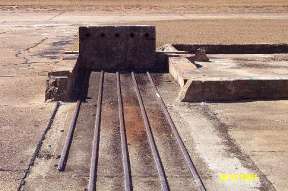
Old Hangar Door Tracks, 2001 |
It was over twenty years ago when I made my last trip back
to what was once Marianna AAF. At that time there were very few
landmarks recognizable; today there are even less. Of the war
years there
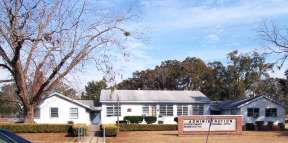
Headquarters Bldg 2001 |
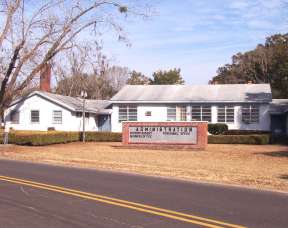
Headquarters Bldg 2001 |
are only two recognizable buildings standing, the
Headquarters and Chapel. The Headquarters building has been refurbished,
but bears some resemblance to the building as it looked during
the war. The Chapel has been remodeled but looks much the same
as it did many years ago.
For many years The State of Florida has been operating
Sunland as an institution for the mentally impaired. Sunland
takes up most of the original Marianna AAF, however only two
original buildings are left and being used, the Headquarters
building and Chapel. Sunland Administration, superintendent personnel
and business offices occupy the old headquarters building now.
At this time Sunland's residents are using the Chapel for worship
services.
| Sunland's perimeter is fenced,
with the fence parallelling the Greenwood to Marianna highway
from the Greenwood Gate to the main entrance to Marianna Industrial
Park. Then parallelling the road into the Park and along the
length of the old flight line, back to the Industrial Park's
Greenwood Gate on the Greenwood Marianna highway. Inside the
Industrial Park are a number of buildings along the old Marianna
AAF flight line area occupied by industry. None of these appear
to be any of the buildings used during the war. As for the tower,
it is not the one used |
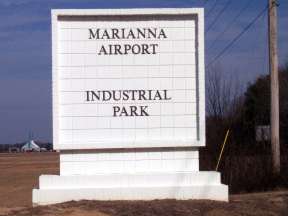
Industrial Park Entrance 2001 |
during flight training at Marianna AAF. I found no
trace of the three Link Trainer buildings that were across the
street from the flight line. I was hoping that I could identify
the area where they were, since I spent many hours in them. There
were lots of pine, and oak trees and undergrowth along the fence
that seems unkempt. I believe it was in this area where two of
the link trainer buildings stood.
See
patches from Graham Air Base

Send Corrections, additions,
and input to:
WebMaster/Editor


|






























